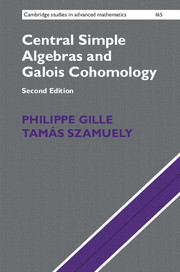Book contents
- Frontmatter
- Contents
- Preface
- 1 Quaternion algebras
- 2 Central simple algebras and Galois descent
- 3 Techniques from group cohomology
- 4 The cohomological Brauer group
- 5 Severi–Brauer varieties
- 6 Residue maps
- 7 Milnor K-theory
- 8 The Merkurjev–Suslin theorem
- 9 Symbols in positive characteristic
- Appendix: a breviary of algebraic geometry
- Bibliography
- Index
1 - Quaternion algebras
Published online by Cambridge University Press: 07 August 2017
- Frontmatter
- Contents
- Preface
- 1 Quaternion algebras
- 2 Central simple algebras and Galois descent
- 3 Techniques from group cohomology
- 4 The cohomological Brauer group
- 5 Severi–Brauer varieties
- 6 Residue maps
- 7 Milnor K-theory
- 8 The Merkurjev–Suslin theorem
- 9 Symbols in positive characteristic
- Appendix: a breviary of algebraic geometry
- Bibliography
- Index
Summary
As a prelude to the book, we present here our main objects of study in the simplest case, that of quaternion algebras. Many concepts that will be ubiquitous in what follows, such as division algebras, splitting fields or norms appear here in a concrete and elementary context. Another important notion we shall introduce is that of the conic associated with a quaternion algebra; these are the simplest examples of Severi–Brauer varieties, objects to which a whole chapter will be devoted later. In the second part of the chapter two classic theorems from the 1930s are proven: a theorem of Witt asserting that the associated conic determines a quaternion algebra up to isomorphism, and a theorem of Albert that gives a criterion for the tensor product of two quaternion algebras to be a division algebra. The discussion following Albert's theorem will lead us to the statement of one of the main theorems proven later in the book, that of Merkurjev concerning division algebras of period 2.
The basic theory of quaternion algebras goes back to the nineteenth century. The original references for the main theorems of the last two sections are Witt [1] and Albert [1], [5], respectively.
Basic properties
In this book we shall study finite-dimensional algebras over a field. Here by an algebra over a field k we mean a k-vector space equipped with a not necessarily commutative but associative k-linear multiplication. All k-algebras will be tacitly assumed to have a unit element.
Historically the first example of a finite-dimensional noncommutative algebra over a field was discovered by W. R. Hamilton during a walk with his wife (presumably doomed to silence) on 16 October 1843. It is the algebra of quaternions, a 4-dimensional algebra with basis 1, i, j, k over the field R of real numbers, the multiplication being determined by the rules
This is in fact a division algebra over R, which means that each nonzero element x has a two-sided multiplicative inverse, i.e. an element y with xy = yx = 1. Hamilton proved this as follows.
- Type
- Chapter
- Information
- Central Simple Algebras and Galois Cohomology , pp. 1 - 18Publisher: Cambridge University PressPrint publication year: 2017



